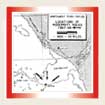|
Page 1 | 2
Foreword
Those who face danger daily in the frontiers
may have every right to pooh-pooh the Great Slave
Lake 1967-68 drilling program. Nevertheless, there
were perils unique to this exercise that were to
send shudders down the spines of those on the job. I
am grateful to R.J. (Jim) Kirker of Canada Northwest
Energy for his story and notes. Al Barlow, Roy
Murray and John Gillard also supplied information.
 The Rainbow 1965 oil discovery in
a Devonian reef set off a second boom in the general
area (Red Earth in 1956 had been the occasion of the
first activity although it had been a Granite Wash
find). Unlike Red Earth, the play moved to the
northeast simply because the rocks which reservoir
oil and gas outcrop along the shore of Great Slave
Lake, These had been mapped many years before and
their names were taken from topographical features
along the shores of that lake (Pine Point, Slave
Point, etc.). Early workers in the area also
reported oil seeps on the north side of the lake. The Rainbow 1965 oil discovery in
a Devonian reef set off a second boom in the general
area (Red Earth in 1956 had been the occasion of the
first activity although it had been a Granite Wash
find). Unlike Red Earth, the play moved to the
northeast simply because the rocks which reservoir
oil and gas outcrop along the shore of Great Slave
Lake, These had been mapped many years before and
their names were taken from topographical features
along the shores of that lake (Pine Point, Slave
Point, etc.). Early workers in the area also
reported oil seeps on the north side of the lake.
This prompted J. Ray McDermott
Canada to file on federal lands covering the western
portion of the lake, knowing that there was little
sedimentary section (the outcrop of the Canadian
Shield was only a short distance away to the east).
During the summer months of 1966, there had been
some seismic shooting from a scow (owned by the
Arctic Missionary Society). An early version of the
air gun was the energy source and Raydist was used
for location fixing. Records revealed a number of
anomalies and it was decided to go ahead and
evaluate these.
Permission was obtained from the Department of
Indian and Northern Affairs and the Department of
Fisheries in 1967 to drill out in the lake.
In late February a modified Failing 1500 owned by
Roy Murray was moved in over an ice road. This track
had been bulldozed the eleven miles from Hay River
and had encountered only one pressure ridge.
However, this was a fresh one and should have been a
warning of dangers yet to come. The ice over this
ridge broke again and required new planking to
bridge it. On March 2, the pressure ridge started
moving once more and the bridging had to be
relocated.
The ice at the wellsite was 40 inches thick and
all agreed that it was sufficient to support the
weight of the rig. This was yet another
miscalculation which later caused problems. The
water depth was 80 feet. The lake bottom consisted
of soft clay so it was possible to drive the
seven-inch conductor pipe some 34 feet into the lake
bottom. Surface casing (31/2 inch) was cemented with
19 sacks at 180 feet. A six-inch Cameron blowout
presenter was installed. Two-inch drill pipe (no
collars) was used with a BQ wire line core barrel to
which was attached a 2 15/16-inch diamond bit.
Despite the fractured nature of the Slave Point
limestones, core recovery was remarkably good.
Murray remembers restoring lost circulation in the
upper porous sections with Jel Plug, a mixture of
aquajel and diesel fuel which set up like jelly.
However, the deeper limestone turned out to be
arterial, flowing warm sulphurous water. It
overflowed the mud tanks and started to melt the
ice. It was essential that fractures from which this
water was flowing be squeeze-cemented, and quickly.
There was some concerns that the sulphur water might
cause an H2S hazard and for a while, masks were in
popular use.
As drilling proceeded, the driller reported the
chuck was resting on the surface casing, This meant
that the weight of the rig and the plasticity of the
ice caused it to sag despite its 40-inch thickness.
The rig had to be jacked up and timbers were laid in
to raise the drill.
At one stage, a fierce blizzard blew up and
drilling had to be stopped. Murray recalls having
the three-ton van with the lighting plant spotted
half-way between the cook house and the rig and
these three landmarks were linked with a nylon rope.
This was the only way of being sure of not being
blown away in the white-out. Murray's wife cooked
for the nine to twelve people on the location.
[Next>>]
|
 Heritage Community Foundation Presents
Heritage Community Foundation Presents


 Heritage Community Foundation Presents
Heritage Community Foundation Presents